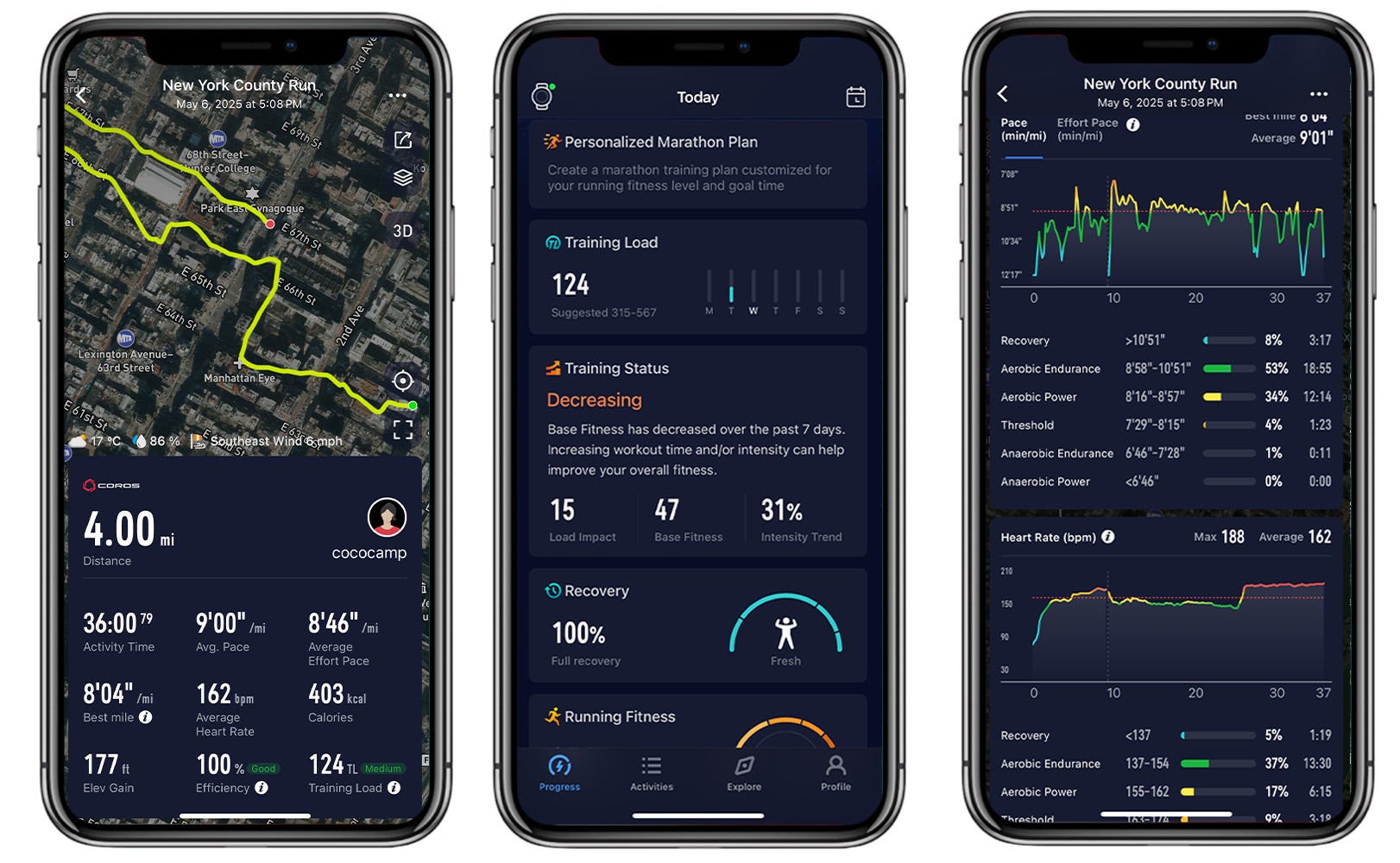The 5 Best Running Watches Are The Key to Managing Your Running Life
Tracking steps and your heart rate is just the beginning.

We earn a commission for products purchased through some links in this article. Why Trust Us?
Ready to ditch the "just tracking steps" vibe? Modern running watches do much more than measuring run distance and heart rate: They can help you dial in your training, map out epic runs, and even whisper (virtually, of course) when it's time to push it or chill out. It’s like having a tiny, genius coach strapped to your wrist. After putting a whole crew of these through their paces, these are the best running watches to wear if you’re looking to optimize your training regimen so you can run faster and longer.
Best Running Watches
- Best Overall: Garmin Forerunner 265 Running Watch
- Best Budget: Coros Pace 3 Running Watch
- Best for Apple Users: Apple Ultra Watch 2 Running Watch
- Best for Teens: Garmin Forerunner 165 Running Watch
- Best Battery Life: Suunto Race Running Watch
What to Consider
Navigating the world of running watches can feel overwhelming, but it boils down to two key questions: How do you run, and how do you live? If your watch is purely a training tool, performance metrics are paramount. But if it's an everyday companion, fit, style, and seamless integration become essential. For dedicated athletes, a 24/7 running watch unlocks valuable insights into recovery, sleep, and overall fitness, paving the way for peak performance.
Display
It’s important that your running watch has a sharp, bright display, which will allow you to see the watch face in bright, sunny conditions, and/or when you check it quickly at a glance mid-run. Right now, the gold standard for watch screens is the active-matrix organic light-emitting diode display, or AMOLED for short. Similar to the technology used in OLED TVs, smartphones, and other tech, these screens are capable of adjusting color and brightness pixel by pixel, ensuring that your stats are easy to read, and the color-coding of your maps pop. You’ll find AMOLED displays on many of my recommendations, including the Garmin Forerunner 265 and the Suunto Race.
While it’s an easy green flag, not every great running watch has an AMOLED display. Especially on budget-friendly options like the Coros Pace 3, which features a transflective surface display, make sure to take a closer look at the pixel density (the number of pixels used to generate the image) and the maximum brightness of the screen, measured in Nits.
Metrics and Data Analysis
For new runners, a simple watch or fitness tracker is your perfect companion, keeping tabs on your pace, distance covered, your heart's rhythm, and those satisfying split times. But for the serious runner craving deeper insights, advanced watches unlock a treasure trove of data. They meticulously track a multitude of metrics, painting a more balanced picture of your performance and how your body responds to training over time. This detailed intel empowers you to spot patterns, fine-tune your training regimen, and truly understand your body's capabilities.

The amount of data these tiny machines can process is wild. A popular metric measured by modern running watches is the capacity to measure VO2 Max. VO2 Max often tops the list of demands for dedicated runners. Think of it as a window into your blood-oxygen levels during exercise. A higher VO2 Max generally points to better overall aerobic fitness and your body's ability to efficiently use oxygen for fuel. Following your VO2 Max trends can reveal just how effective your training is and highlight improvements in your cardiovascular health – aka motivation you can measure.
Most fitness watches also offer some kind of sleep tracking, which records your blood oxygen level, movement, and heart rate at rest to assess the quality of your sleep. As a dedicated insomniac, I value this type of tracking almost as much as the timing of my splits and my recovery, even if the data arches toward the depressing.
Most fitness watches offer some kind of sleep tracking, which records your blood oxygen level, movement, and heart rate at rest to assess the quality of your sleep.
With the success of the Whoop fitness tracker, more and more watches offer some sort of recovery analysis. Similar to sleep tracking, your watch analyzes bio-data to help you identify overtraining, undertraining, and even potential underlying illnesses.
If you menstruate, many running watches also offer period tracking that you can set up to alert you of your next oncoming curse.
Companion Apps
Most running watch brands make a companion app that allows you to visualize your run data on your phone. They also make it easier to adjust settings, download maps, and connect with other runners (if you’re into that). If you have an iPhone, then you’re already familiar with Apple Fitness. Garmin, Coros, and Suunto all have companion apps with similar functionality, though they’re not all created equally.
Lifestyle Features
Beyond data tracking, running watches offer a host of apps and features that are useful, but may not be that important for training.
First, pretty much every fitness watch is able to track a wide variety of workouts, not just running. Most can also control a host of apps and features on your phone, including contactless payment systems (Apple Pay, Google Pay) music streaming apps (Spotify, Apple Music, etc), so you don’t need to look at your phone.
If you don’t even want to bring your phone on your runs, some watches can connect to mobile internet independently (if you add them to your phone data plan.)
Battery Life
Battery life on running watches has improved dramatically over the past several years. Most brands measure it in terms of days (or weeks!) rather than hours.
Ultrarunners taking part in multi-day races need watches with a ton of life in them, but a few days is more than enough for most runners who just need it to last through their run and their sleep cycle.
Comfort
A bulky running watch can be a major distraction. Pay attention to the watch's size, how it feels on your wrist, and the availability of third-party straps that may create a more comfortable fit. Some of our picks come in multiple sizes, and we’ve found that to be a real boon for both petite and larger wrists.
Why Trust Us
The team at Runner’s World has been testing products for decades. We have designed and built thorough testing formulas for every product that we test. We are runners, just like you, and we care about your experience with the products we recommend.
We get the importance of reliable data and comfortable wear during runs. We know that a running watch isn't just a gadget; it's a tool that can significantly impact a runner's training and overall experience. We know that these watches need to work for not just the pros, but also beginning runners. Our recommendations are grounded in real-world testing and a genuine desire to help you find the best gear for your needs.
Personally, I’ve been running for decades, competing in multiple marathons, and completing years-long running streaks. As a gear tester, I’ve been putting products through their paces for over 10 years, learning how to determine what buyers want the most, which products work the best, and how best I can present those choices.
How We Tested
The Runner’s World team has been testing smart watches for years. In 2025, I’ve personally already tested more than half a dozen watches. Runner-in-Chief Jeff Dengate and Running Reviews Editor Amanda Furrer have both put several of them through the wringer as well. For our “best for teens” pick, we enlisted the help of three actual teenagers who run regularly to get very honest feedback on everything from utility to aesthetics.
Obviously, we ran all over the place in these devices. We went to their apps and downloaded routes and maps to evaluate whether or not they matched their description while also scoping out the variety of routes available. We ran in the wilds of Pennsylvania, the streets of New York City, and the hills of the Scottish Highlands. We ran on the track and on treadmills and back again.
We tested distance accuracy by running pre-measured routes and recording laps. We meticulously tracked distance and time to confirm how well it measured our pace. We evaluated the accuracy of the GPS by taking these watches deep in the woods, off trails on high peaks, and in other areas notorious for GPS disruption.
Our team, excluding the teen testers, evaluated each watch's integration with Strava, the ubiquitous running and training app. Additionally, I personally tested the watches with Runna, Peloton, Joggo, and Nike Run Club. During these tests, we zeroed in on measuring how quickly and reliably each watch interacted with the app, checked how often and effectively the app sent alerts to the watch, and assessed the overall usability of the app on each watch. Anyone who’s been prompted to take a wrong turn on Strava knows how annoying a lag can be. (Also, I once ran onto private property and the wedding party on that pier was very confused.)
Our testing went far beyond just logging miles. We put these watches through the paces of daily life, exploring everything from strength training integrations and app compatibility with services like Spotify and MyFitnessPal, to fun and practical features like contactless payments, music playback, and even phone calls. We wanted to get a feel for how these devices truly fit into our whole day whether we’re running or not.
Athletes are hard on their things, it’s just a fact, so we were not precious with these watches. We wore them in the rain, the snow, freezing cold climates, hot weather, and in and out of the shower. Since I am the klutziest person known to man, the watches were banged on corners and dropped multiple times from waist height. My husband even stepped on my watch after I’d left it on the living room floor where I decided to die after a grueling long run. The Suunto survived with nary a scratch.
Full Reviews
Cat Bowen has been covering parenting and home for over a decade. At Best Products, she has tested hundreds of products for parents and for the home, often spending dozens of hours per product to ensure her reviews are accurate and informative. Prior to joining the team, she was at Romper where she covered everything from breastfeeding to child sleep habits to abortion rights access. You can find her work on Bustle, Romper, and more. Cat is a bit of an intellectual magpie and perpetual student, most recently receiving a graduate degree in gender studies where she examined a topic that vexes so many — pockets in women’s clothing.
Jeff is Runner-in-Chief for Runner’s World and the director of product testing. He has tested and reviewed running shoes, GPS watches, headphones, apparel, and more for nearly two decades. He regularly tests more than 100 pairs of shoes each year, and once had a 257-day streak running in different models. Jeff can usually be found on the roads, racing anything from the mile to a marathon, but he also enjoys racing up mountains and on snowshoes. When he’s not running, you’ll probably find him hanging from a ladder making repairs and renovations to his house (he’s also director of product testing for Popular Mechanics).

Readers Also Read

The Best Basic Running Watches for Minimalists

The Best Basic Running Watches for Minimalists

The 6 Best Garmin Running Watches

The 6 Best Garmin Running Watches










